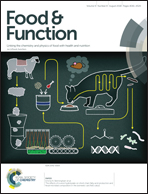Understanding the influence of carrageenan oligosaccharides and xylooligosaccharides on ice-crystal growth in peeled shrimp (Litopenaeus vannamei) during frozen storage
Abstract
Cryoprotective saccharides are widely accepted antifreeze additives that reduce thawing loss, maintain texture, and retard protein denaturation in frozen seafood. In this study, the inhibition effects of carrageenan oligosaccharides and xylooligosaccharides on ice-crystal growth in peeled whiteleg shrimp were investigated and compared with sodium pyrophosphate treatment during frozen storage, especially the interactions between oligosaccharide molecules and ice crystals. The tissue microstructural results demonstrated that the fibers of shrimp muscle tissues from carrageenan oligosaccharide- and xylooligosaccharide-treated groups were arranged in a more tighter manner than those with sodium pyrophosphate treatment after 8 weeks of storage, which indicated that soaking in oligosaccharide solutions prior to freezing markedly slowed the damage caused to muscle tissues by large ice crystals. Ice-growth inhibition might play an important role in the cryoprotection of frozen shrimp. Furthermore, molecular docking and molecular dynamics (MD) simulations confirmed that oligosaccharides were generally close to the ice surface and embedded in ice layers via hydrogen bonds or hydrophobic or electrostatic interactions. The oligosaccharide–basal ice complex (ice-crystal structure) was partially destroyed, and some dislocation and disaggregation were observed around the oligosaccharide molecules. Thus, the incorporated oligosaccharides suppressed the growth of ice crystals, providing protection from freeze-induced damage. Overall, by comparing the experimental results to those from the MD simulations, a significant positive correlation existed between the oligosaccharides and ice-growth inhibition in shrimp muscle. These findings help better understand the cryoprotective mechanisms of oligosaccharides in frozen shrimp, and these two oligosaccharides may be potentially used as ice-growth inhibitors in seafood to maintain better quality during frozen storage.



 Please wait while we load your content...
Please wait while we load your content...